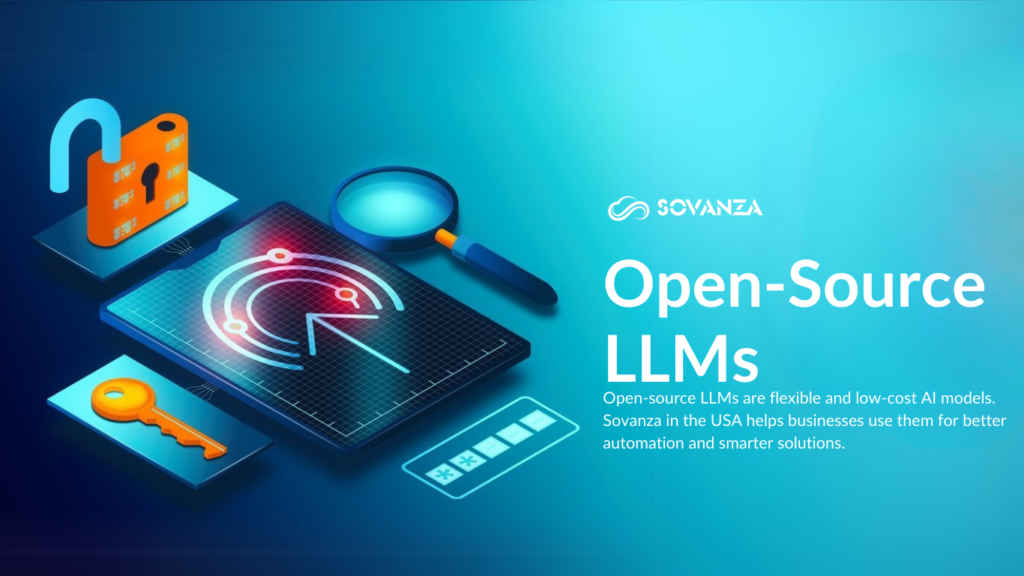
Introduction
Open-source LLMs (Large Language Models) are transforming the AI landscape by providing businesses with powerful, customizable alternatives to proprietary models. Unlike closed-source solutions, these models offer transparency, flexibility, and cost-effectiveness, enabling companies to fine-tune AI for specific industry needs. In 2025, open-source LLMs will continue to gain traction across various sectors, from customer service automation to advanced data analysis.
Sovanza, a leading AI solutions provider in the USA, specializes in integrating open-source LLMs for businesses across multiple industries. With expertise in model training, deployment, and AI workflow integration, Sovanza helps companies leverage the full potential of open-source AI while ensuring seamless implementation and ongoing optimization. Whether in e-commerce, healthcare, or legal automation, Sovanza empowers businesses with cutting-edge AI solutions tailored to their unique needs.
What Are Open-Source LLMs?
Open-source LLMs are large language models with publicly accessible designs, training data, and weights. Unlike private models, which need licensing fees and API subscriptions, open-source models allow organizations to customize, fine-tune, and deploy AI based on their requirements. This strategy provides better control over AI implementation, making it perfect for firms that value customization and visibility.
Top Open-Source LLMs
The open-source AI environment constantly changes, with numerous cutting-edge models setting the pace. These models offer powerful alternatives to proprietary AI while increasing flexibility, transparency, and cost-effectiveness. Here are the top open-source LLMs:
Mistral 7B
Mistral 7B is a highly efficient open-source LLM designed for optimal performance with fewer computational resources. It is known for its superior reasoning abilities and compact architecture, making it ideal for chatbots, automation, and business applications.
Meta’s LLaMA 3
The third iteration of Meta’sMeta’s LLaMA (Large Language Model Meta AI) series has significantly improved accuracy, scalability, and contextual understanding. LLaMA 3 is widely adopted for research, enterprise AI, and language processing tasks.
RedPajama
RedPajama is an open-source alternative to ChatGPT, built with transparency and reproducibility in mind. It is widely used in academia, business intelligence, and automated content generation.
OpenLLaMA
An open-source replication of Meta’ sMeta’s LLaMA models, OpenLLaMA is designed for developers who want to customize and deploy LLMs without proprietary restrictions. It provides a flexible foundation for AI-driven applications.
StarCoder
Designed for AI-assisted programming, StarCoder is an open-source LLM that helps developers write, debug, and optimize code across multiple programming languages.
What types of Projects can Open-Source LLM Models enable?
Open-source LLM models enable projects like chatbots, content creation, translation, sentiment analysis, and data-driven applications.
AI-Powered Customer Support
Open-source LLMs can be used to create intelligent chatbots and virtual assistants that answer client questions, process support issues, and deliver real-time responses. Businesses can fine-tune these models using industry-specific insights to increase customer satisfaction while lowering operational costs.
Automated Content Creation
Companies can use open-source LLMs to create high-quality material for blogs, social media, marketing campaigns, and product descriptions. These models help to streamline content operations, guaranteeing consistency in brand messaging while decreasing the need for manual authoring efforts.
AI-Assisted Code Generation
Developers use LLMs for code generation, debugging, and documentation, significantly accelerating software development cycles. Models like StarCoder and GPT-NeoX help engineers write efficient, optimized code while reducing human errors in programming.
Data Analysis and Business Intelligence
Open-source LLMs allow firms to handle huge data sets, extract useful insights, and provide automated reports. These models help with predictive analytics, trend identification, and decision-making, making them invaluable in the banking, healthcare, and e-commerce industries.
Key Benefits of Open-Source LLMs
Open-source LLMs offer cost-effective, customizable, and transparent AI solutions, enabling innovation, collaboration, and greater accessibility.
Cost Savings
Customized AI models can come with high API fees, making them less accessible to startups and mid-sized organizations. Open-source LLMs eliminate these fees, enabling businesses to create and maintain AI solutions for a fraction of the cost.
Customization and Flexibility
With open-source models, organizations can fine-tune AI with industry-specific data, enhancing accuracy in specialized domains like healthcare, finance, legal services, and e-commerce. This level of customization is impossible with proprietary models.
Avoiding Vendor Lock-In
Relying on closed-source AI models can lead to dependency on third-party providers, making businesses vulnerable to pricing changes, API limitations, and service outages. Open-source LLMs offer autonomy, allowing companies to host AI on their infrastructure.
Transparency and Ethical AI
Proprietary models operate as “black boxes,” meaning their decision-making processes are hidden. Open-source alternatives enable businesses to audit the AI’s reasoning, detect potential biases, and ensure ethical AI implementation. This transparency is essential for compliance with regulations like GDPR and HIPAA.
Why Businesses Choose Sovanza for AI Integration
Businesses choose Sovanza for AI integration due to its expertise in automation, data-driven solutions, and seamless implementation for optimized efficiency.
Custom AI Model Training
Sovanza fine-tunes open-source LLMs using industry-specific data, ensuring the AI model understands niche terminology and workflows. This customization enhances accuracy, making the AI more effective for specialized applications like healthcare, finance, and e-commerce.
Scalable AI Hosting Solutions
Businesses can deploy AI solutions on their servers for maximum security or leverage cloud platforms for scalability. Sovanza provides end-to-end support, ensuring seamless deployment while optimizing performance based on infrastructure needs.
AI Workflow Integration
We integrate AI-powered automation into existing business processes, enhancing efficiency across customer support, content generation, and data analysis. Sovanza ensures smooth implementation with minimal disruption to operations, maximizing productivity.
Ongoing Optimization
Sovanza continuously monitors AI performance and fine-tunes models for accuracy, speed, and efficiency. Regular updates, retraining, and security enhancements keep AI solutions up to date, ensuring long-term business success.
Multi-Language Support and Localization
Sovanza customizes open-source LLMs to support multiple languages and dialects, making AI more accessible for global businesses. Our localization expertise ensures that AI-powered solutions resonate with diverse customer bases.
Real-World AI Success with Sovanza
Sovanza drives real-world AI success by delivering intelligent automation, data insights, and innovative solutions that enhance business performance.
AI-Powered E-Commerce in New York
A leading e-commerce company in New York partnered with Sovanza to integrate an open-source LLM for personalized product recommendations and automated customer support. The AI-powered chatbot reduced response times by 60%, improving customer satisfaction and boosting sales conversions.
Legal Automation in Los Angeles
A law firm in Los Angeles used Sovanza’s expertise to implement an AI system for drafting contracts and legal documents. By leveraging open-source LLMs, the firm reduced manual paperwork by 50%, allowing attorneys to focus on complex legal cases while improving efficiency.
Healthcare AI Solutions in Chicago
Sovanza helped a Chicago-based healthcare provider deploy an AI-powered data analysis system to process patient records and generate insights for treatment plans. This solution improved diagnostic accuracy and streamlined administrative tasks, enhancing patient care.
Get Started with Sovanza for Open-Source LLM Solutions
Sovanza is your trusted partner for implementing open-source LLM solutions tailored to your business needs. Whether you demand AI-powered automation, advanced data processing, or custom model fine-tuning, our professionals guarantee easy integration and peak performance. From startups to enterprises, we assist businesses across the United States in harnessing the power of open-source AI for cost-effective, scalable, and secure solutions. Contact us today to see how our AI expertise may help you modify your operations and gain a competitive advantage.
Conclusion
Open-source LLMs transform AI development by providing affordable, adaptable, and transparent alternatives to proprietary models. Businesses can use these models for automation, content generation, coding support, and data analysis while completely controlling customization and deployment. As AI evolves, open-source solutions offer a new avenue for enterprises seeking to leverage advanced language models without vendor constraints.
Sovanza is at the forefront of AI integration in the USA, helping businesses adopt open-source LLMs for enhanced efficiency and scalability. Our expertise in custom AI training, workflow automation, and secure hosting ensures that companies can fully optimize AI solutions tailored to their industry needs. With Sovanza, businesses gain a competitive advantage by leveraging cutting-edge AI without proprietary platforms’ high costs and limitations.
FAQs
What are Open-Source LLMs?
Open-source LLMs are large language models with publicly available code, training data, and weights. They allow customization and deployment without licensing restrictions. They offer businesses greater flexibility, transparency, and cost-effective AI solutions.
What makes open-source LLMs different from proprietary models?
Open-source LLMs provide publicly available architectures, training data, and model weights, allowing businesses to modify, fine-tune, and deploy AI according to their needs. While proprietary models require licensing and limit flexibility, they are publicly available.
Can Sovanza provide multi-language AI solutions?
Yes, Sovanza customizes open-source LLMs to support multiple languages and dialects. Our AI solutions ensure accurate localization for businesses targeting diverse global audiences.
Which industries benefit most from Sovanza’s open-source LLMs?
Sovanza’s open-source LLMs benefit industries like healthcare, finance, e-commerce, legal services, and customer support. These AI solutions enhance automation, data analysis, and workflow efficiency across various sectors.
How do Sovanza’s open-source LLMs reduce costs?
Sovanza’s open-source LLMs eliminate expensive licensing fees and API costs, allowing businesses to deploy AI solutions affordably. They also reduce operational costs by automating customer support, content creation, and data analysis tasks.

